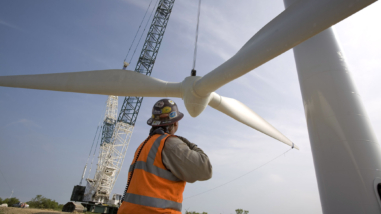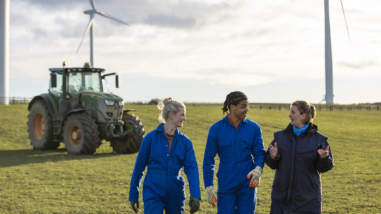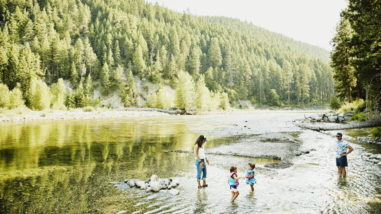Reflections on creating a philanthropic wildfire strategy
In 2020, the Hewlett Foundation embarked on a three-year wildfire initiative that was developed and led by Environment Program Fellow Jennee Kuang. As the fellowship draws to a close, Jennee shares her reflections as someone who came to Hewlett new to philanthropy and relatively new to the wildfire field. The Hewlett Foundation’s Environment team plans to continue supporting wildfire resilience in the Western United States via grantmaking to grow and expand Resources Legacy Fund’s own wildfire strategy.
I joined the Hewlett Foundation in July 2019 as the Environment Program Fellow to, according to the job description, “help develop and manage a grantmaking project intended to assess and address the climate implications of land use in the Western United States and Canada, potentially focused on wildfire.” Hot on the heels of a devastating 2018 wildfire season, I ran with, and was quickly consumed by, the wildfire focus.
I kicked off the development of a wildfire strategy with a review of written and accessible information, which was sufficient for me to realize our grantmaking intervention needed to focus on wildfire resilience rather than fire suppression or disaster response. But publicly available and easily accessible information had its limitations. As such, the strategy Hewlett eventually adopted was shaped significantly by the expertise of many generous people, including both the broader community of wildfire resilience champions and my exceptional Hewlett colleagues.
In three years, I’ve been fortunate to play a role in the ability of tribes, nonprofits, land use planners, and others to make significant progress on wildfire resilience. We’ve seen decisionmakers shift their attention to helping public land managers and communities prepare for wildfires before they occur rather than reacting only when a wildfire has already struck. We’ve seen more recognition of and investment in cultural and prescribed burns as an essential tool for wildfire resilience. We’ve seen an unprecedented scale of public funding committed to resilience, which has historically been chronically underfunded. And we’ve begun to build more inclusive collaboration that goes beyond the traditional wildfire and forest health community.
But more work remains. That’s why I’m excited that Hewlett plans to continue its support for wildfire resilience by investing in the growth of Resources Legacy Fund’s wildfire program. I am fortunate to be joining RLF this August to support the expansion of the program and to continue exploring opportunities to facilitate funder collaboration on wildfire resilience.
Here are six lessons I am taking with me as I prepare for my new role.
Approach the work with humility and listen
There are many remarkably sharp and dedicated people out there who are working every day to push wildfire resilience forward. Hewlett’s strategy was welcomed by wildfire experts because it reflected the voices of wildfire experts. And wildfire experts come from all corners – community-based fire practitioners, cultural burners, policy wonks, public agency staff, fire ecologists, land use planners, and more.
Prioritize trust-based relationships
Capacity in the field of wildfire resilience right now is very lean. Meaningful collaboration and relationship-building are important in the best of times, but even more important when capacity is so constrained. I spend much of my time trying to understand the relationships in the field. Who works where? What reputations do individuals have in the field? What are their organizations’ reputations? Who works in a truly collaborative fashion? Who says they work in a collaborative fashion but actually boxes other voices out? Trying to understand and be sensitive to these dynamics is a critical part of doing this job strategically.
Make the time to get it right
It took me over two years to become literate enough in wildfire resilience policy that I could serve as a real thought partner in the field. It’s difficult to make strategic funding decisions in this space without this amount of time unless you have trusted partners to advise you. And even then, you need enough understanding of the field to identify those trusted partners.
Embrace uncertainty and adapt as needed
I came to Hewlett entirely new to philanthropy and still relatively new to wildfire, which means I was charged with developing a new strategy while also learning about grantmaking for the first time and climbing the steep learning curve of the wildfire space, all while the political and funding context was shifting rapidly around me. I needed comfort with operating in this environment of uncertainty. In practice, this meant being flexible on how the strategy was implemented and being flexible with grantees while they work to hit a moving target. I also had to be patient with myself as I learned to navigate two complex fields in real time.
Recognize that if the solution sounds simple, it’s probably not very effective
One of the big challenges of the wildfire space is how complex the issue is. Explaining how intentionally setting fires is a management tool when peoples’ homes are burning down is not particularly palatable or immediately intuitive, for example. Explaining how our public agencies have governance structures built around fire suppression and not fire resilience tends to make people’s eyes glaze over. There’s no single new widget that’s going to move us substantively forward on this issue. Making our communities and landscapes wildfire resilient requires changing complex political, sociocultural, economic, and other dynamics, many of which don’t want to be changed.
Visit communities to begin to understand the complexity of fire
Despite pandemic travel limitations, I was able to make two trips in October 2021 to Northern California for the Yurok and Klamath prescribed fire leaning exchanges (TREX). I had, at this point, spent many, many hours reading about and talking about fire — mostly perched in front of my screen in my Bay Area apartment. But I can’t say I really knew what I was funding until some of my grantees showed me what fire meant within the place they call home. This was a powerful reminder of the need to prioritize getting to know and learning from the communities your work touches.
Looking back at the trajectory of wildfire resilience over my tenure at Hewlett, both for the foundation and for the broader field, is a dizzying experience. And yet, there’s still so much more to be done. I feel very lucky to have the opportunity to stay within this community of thoughtful, dedicated wildfire resilience champions in my next role, working toward a Western United States that re-imagines our social, cultural, and political systems and physical infrastructure in a way that embraces the reality of living within fire-adapted and fire-dependent landscapes.




